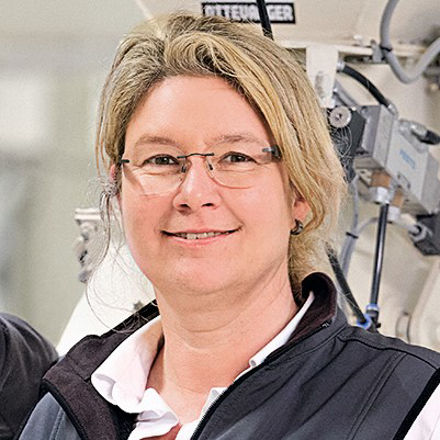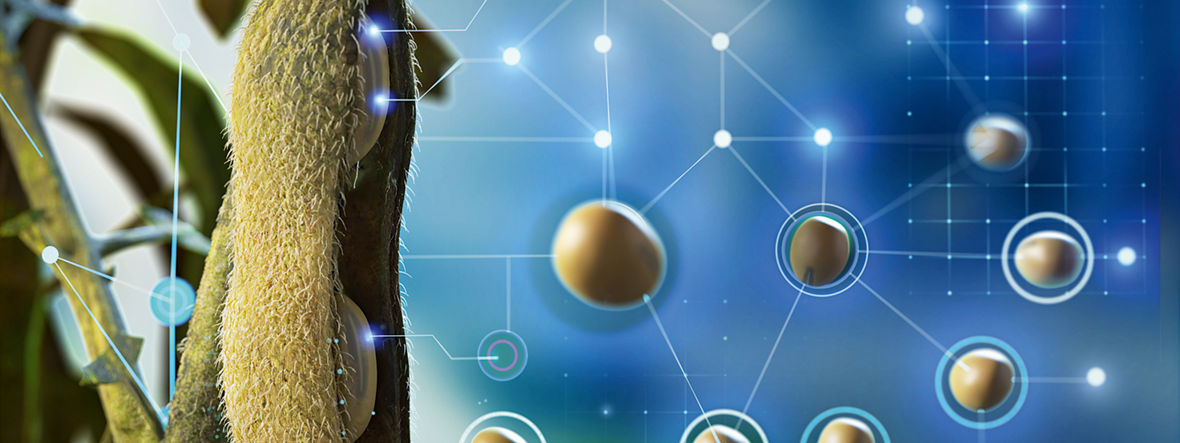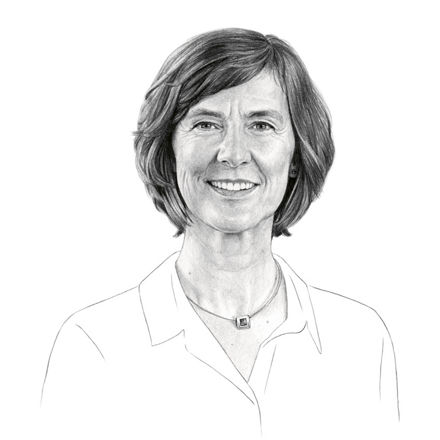It’s already late afternoon, and the Eurohafen harbor in Haren (Ems) isn’t very busy. Only the Rothkötter company’s jetty has two barges still moored to it. Carrying a white plastic bucket and a long metal rod, a compound feed miller leaves the adjacent plant and quickly walks the few meters to the water. After the miller has a brief talk with the captain, the latter opens the cover of the cargo hold to reveal 1,000 metric tons of wheat. The miller boards the barge and pushes the sampling rod into the grain at different depths in several places according to a predetermined pattern. He then fills the samples into plastic bags.

Rothkötter Mischfutterwerk produces chicken and pig feed at three locations in Germany. The most important raw materials for this feed include grains such as wheat, oilseeds such as soy or rapeseed, and by-products from food production. Feed is a key factor when it comes to the profitability and sustainability of livestock farming. The origin of the raw materials, their respective composition, and the addition of additives have a decisive influence on animal welfare and meat quality. In order to create feed that is optimized in all these respects, manufacturers need to know the exact composition of all the components. That is why no company can do without state-of-the-art analytics. Rothkötter relies on Evonik’s feed analytics to exploit a stream of constantly new raw materials, including many from the local area.

The laboratory at the Rothkötter compound feed plant in Meppen, just a few kilometers away, is located directly at the factory entrance. A sampler hovers above the scales on which all trucks delivering raw materials must stop. Maria vor dem Brocke can control the sampler remotely from the laboratory building. She takes samples, inspects them, and determines some simple parameters such as the moisture content. She also prepares raw material samples—including those taken at Eurohafen—for near-infrared (NIR) analysis.
A device the size of a conventional desktop printer takes less than a minute to analyze a sample. The result can be seen on the connected monitor in the form of colored curves. Once the measurements have been completed, vor dem Brocke transmits all the results to Evonik online. Fifteen minutes later, the computer tells her the content of protein, fat, fiber, sugar, phosphorus, ash, amino acids, and other components in each sample.
This knowledge is crucial for Christian Emthaus, the managing director and head of Rothkötter’s three compound feed plants. “We know the nutritional requirements of chickens and pigs in their respective development phases very well, and we tailor the feed to these requirements,” he says. Emthaus always has to adjust the composition of the ingredients, because plant-based ingredients vary greatly depending on the variety, origin, weather, and type of storage. Moreover, the availability of raw materials also fluctuates enormously.
The protein content of the feed is a very important parameter for the growth of the livestock. “The amino acid composition is crucial here,” explains Dr. Maike Naatjes, an agricultural engineer specializing in animal nutrition. She works at Evonik’s Animal Nutrition business line and provides technical support to customers in Europe, the Middle East, and Africa. She is also in close touch with Christian Emthaus.

CUTTING PROTEIN CONTENT
Of the 21 different amino acids that make up proteins, animals are unable to produce eight themselves. These amino acids are known as essential amino acids and they must be supplied in sufficient quantities via the feed. “As soon as one of the required essential amino acids is used up, the animal can no longer utilize the excess of the other protein components that are present,” explains Naatjes. “They have to be metabolized and excreted in the urine.” This effect must be avoided for several reasons: Protein-rich raw materials are expensive and take up agricultural land. The animals’ excrement contributes to the overfertilization of soil and water. Moreover, the proteins put the animals’ organisms under unnecessary strain.

In order to achieve a balanced amino acid ratio with less raw material, many manufacturers add small amounts of pure amino acids to the feed. Chickens are most often deficient in methionine, while pigs are first and foremost deficient in lysine. Evonik offers the three most important amino acids in its product range.
But how much of which additive is needed in each mixture? Before the introduction of NIR analysis, feed manufacturers worked with data from complex wet chemical analyses that companies such as Evonik carried out on raw material samples from all over the world and published once a year. “Back then, we knew, for example, that European wheat contains nine to 13 percent protein and that the majority of samples contain ten to 11.5 percent,” says Emthaus. To be on the safe side, he always set the quality of the raw material slightly lower than the known average in order to get an approximate value for the methionine requirement, for example.
Today, with the support of fast NIR technology, the formulation of animal feed is daily precision work. Large manufacturers such as Rothkötter have their own NIR devices but rely on Evonik’s support for evaluating the analysis data. This is because NIR analysis is an indirect method that can’t determine the total quantity of the components of the raw material. In order to correctly evaluate the measured spectra, data sets with the known content or concentrations of a substance are needed. Evonik has built up and constantly expanded these data sets over decades. “In the laboratory, we’ve thoroughly analyzed millions of samples of more than 60 different raw materials from all over the world,” says Naatjes. They form the basis for the company’s AMINONIR® service.

Rothkötter uses NIR analysis on a random basis for known suppliers and for deliveries by truck. Deliveries of raw materials by barge or rail, which involve much larger quantities, are checked more closely. In such cases, Managing Director Emthaus sometimes waits for the results of the analysis before deciding which silo to store the raw material in. The components are then processed and mixed fully automatically in the multi-level feed mill. In one day, more than 1,000 metric tons of compound feed are produced in this way at the Meppen site.
By combining state-of-the-art analytics and a growing range of additives, Rothkötter has been able to steadily reduce the protein content of the feed over the years. “Before the first amino acid, methionine, was available as an additive, poultry feed, for example, contained around 30 percent protein,” says Emthaus. Today—with the addition of several amino acids—it is only 19 percent. Evonik calls this concept “low-protein diets,” in which the animals’ amino acid requirements are met with less crude protein.
HOW THE ANALYSIS WORKS

REDUCING NITROGEN EMISSIONS IS THE GOAL
For many years, optimization was primarily based on economic considerations, as feed is by far the biggest cost factor in livestock farming, and proteinaceous raw materials are particularly expensive. Sustainability has increasingly played a role as well. “It has become clear that the crude protein content in the feed also determines its environmental footprint,” says Emthaus. “This gives us an effective means of improving sustainability.” Because the Rothkötter Group not only produces compound feed but also processes the chickens it feeds into meat products, it can also reap rewards with retailers and environmentally conscious end consumers.
A publication by the German animal nutrition association Deutscher Verband Tiernahrung (DVT) from 2022 shows that the use of amino acids is effective. According to the article, the crude protein content in chicken feed from the five leading producers in Germany fell from an average of 20.8 percent in 2000 to 19.3 percent in 2020. This corresponds to a relative change of seven percent. At the same time, the animals reach a higher weight. If the crude protein content is related to the live weight of the chickens, the amount of protein used has actually decreased by 18 percent.

»In animal feed, it’s the amino acid composition that counts«
Maike Naatjes agricultural engineer at the Evonik business line Animal Nutrition
Another benefit is that less ammonia is produced if farm animals excrete less unused protein and therefore less nitrogen. Ammonia is a nitrogen compound that is problematic in several respects: If it reacts with certain air pollutants, it can produce particulate matter that is hazardous to health. In water and soil, ammonia can lead to eutrophication and acidification.
The EU has therefore limited the permitted level of ammonia emissions. In Germany, for example, emissions will be limited to 431,000 metric tons per year from 2030. A protein-reduced diet helps to achieve this goal. According to the DVT, the calculated nitrogen emissions per kilogram of chicken in Germany fell by more than a third between 2000 and 2020, from 31 grams to 20 grams.
The animals also benefit from the adjusted diet, as Emthaus explains: “They excrete less unused protein. Moreover, chicken manure contains less water because nitrogen emissions and water consumption are linked. The animals are drier in the barns, which reduces the risk of bacterial infections.”
PROTEIN FROM LOCAL SOURCES
When it comes to making animal feed more sustainable, Rothkötter also relies on local raw materials, whose quality is also carefully analyzed. By-products from local food production are particularly attractive. These include shell residues that are produced when milling grains such as wheat. “The products we use for animal feed can be consumed by humans to only a limited extent or not at all. However, the resulting meat contains high-quality protein for human consumption,” says Emthaus. Oil extraction from rapeseed or sunflowers also produces by-products that can be used as animal feed. Rothkötter’s purchasing/recipe design team monitors raw material exchanges to track exactly which components are available when. It also receives offers via direct contacts with food producers. If the raw material base of the feed changes, the overall mixture must be reformulated. Rothkötter usually does this once a week.
The feed for broiler chickens and pigs consists of five to 15 main components and a number of smaller ingredients. Changes should be kept to a minimum so that the animals do not have any problems with the change in feed. Nowadays, software helps to adjust feed mixes. This allows feed to be optimized in terms of quality, sustainability, and cost-effectiveness.

The feed for broiler chickens and pigs consists of five to 15 main components and a number of smaller ingredients. Changes should be kept to a minimum so that the animals do not have any problems with the change in feed. Nowadays, software helps to adjust feed mixes. This allows feed to be optimized in terms of quality, sustainability, and cost-effectiveness.
Soybean meal is an indispensable raw material, as it has the most favorable amino acid composition of all plant components for animal feed. Just like rapeseed meal, it is a by-product of oil production. Rothkötter Mischfutterwerk sources it from South America and Europe.
ELEMENTS-Newsletter
Receive exciting insights into Evonik's research and its social relevance - conveniently by e-mail.
In order to make soybeans suitable for consumption by animals and humans, they are first heated by oilseed processors. This is necessary to deactivate certain substances in the legume. However, excessive heat destroys heat-sensitive amino acids in soybeans. This heat treatment, known as toasting, is a balancing act that doesn’t always work perfectly, but has a very significant impact on the digestibility of the soybean meal and therefore its quality as animal feed.
Evonik scientists have developed a patented process that uses NIR analysis to determine how well soybean meal can be digested. This enables Rothkötter to make the raw material more usable with the help of added amino acids.
Like all other ingredients, the meal is transported in the most environmentally friendly way possible—for example by freighter to Rotterdam and then by barge, rail or truck to the plant. When it comes to the environmental footprint of a plant-based raw material, the efficient use of land also plays a decisive role. It depends on factors such as soil conditions, weather conditions, and size. This means that certified soybean meal from South America, where two harvests per season are possible, can perform just as well as European soybean meal in the overall assessment.

In addition to analytics, life cycle assessments are an important driver of feed optimization. TÜV Rheinland has certified a life cycle assessment that Evonik conducted in 2021, which shows that the greenhouse effect of livestock farming in Europe could be reduced by nine to 14 percent and overfertilization by nine to twelve percent simply by supplying broiler chickens, laying hens, and pigs with low-protein feed and adding free amino acids. In addition, the amount of arable land used could be reduced by up to 13 percent. Rothkötter and Evonik show how it’s done



